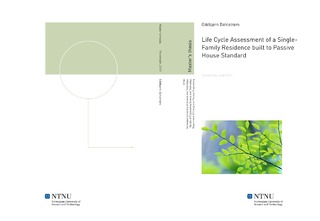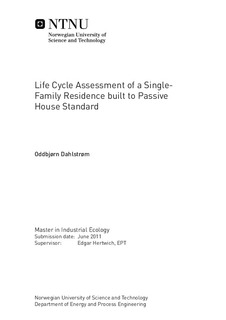| dc.description.abstract | Two complete cradle to grave life cycle assessments are conducted for the comparison of a house built after today s building standard, TEK07, and a passive house built after the Norwegian Standard NS 3700:2010. Both houses are projected by the building company Nordbohus AS, and are to be constructed in Stord, on the west coast of Norway. The usable floor area, BRA, is 187 m2 for both houses, and a lifetime of 50 years is assumed. The houses are constructed with a wooden framework, insulated with mineral wool in the walls and roof, and have a ground lever floor of reinforced concrete on a layer of expanded polystyrene. The passive house has, compared to the TEK07 house a different foundation, 15 cm more mineral wool in the outer walls, 5 cm more in the roof, and better insulated windows and doors. In addition, the thermal conductivity for the outer wall insulation is reduced for the passive house. The house life cycle is divided into several phases. Construction of the house, waste treatment of materials connected to the construction, surface finish and maintenance of the house during the lifetime, water and electrical energy consumption during the house operation and finally demolition and waste treatment of the materials after the end of the house lifetime. Transportation of workers and materials to the construction site, as well as to waste treatment plant, are included. Generic data from Ecoinvent 2.0 database is used, but some processes are modified to satisfy Norwegian production information. The Nordel electricity mix is used for Norwegian production and house electricity consumption. SimaPro 7.1.8 is used to process the data, and the ReCiPe method, hierarchist midpoint version 1.03 is used for the impact assessment. It is assumed that both houses have the same heating system, and cover 100% of the energy needs from electrical energy. For the 50 year life cycle, the passive house has 20% less impacts to climate change than the TEK07 house. For the other categories assessed, the passive house has between 10-20% lower impacts than the TEK07 house. The only exception is impacts to freshwater ecotoxicity, where the passive house impacts are increased with 7% from the TEK07 house. The TEK07 house has impacts to climate change with 1,6 tons CO2 eq/m2 useful floor, while the passive house 1,3 tons CO2 eq/m2 useful floor. Cumulative energy demand is 55 GJ/m2 and 42 GJ/m2 respectively. The construction phase is responsible for 13%, waste treatment of materials connected to construction 1%, surface finish and maintenance 6% and end of life waste treatment 4% of overall climate change impacts for the TEK07 house. Water and electricity consumption during the operation are thus responsible of 76% of the TEK07 life cycle climate change impacts. For the passive house, this is 19%, 1%, 7%, 6% and 67% respectively. Main activities contributing to the overall impacts are transportation of materials, workers and waste to and from the construction site, diesel combusted in building machines, production and incineration of EPS/XPS and paint, waste treatment of wood ash, and production of cement and ceramic tiles.A sensitivity analysis of energy consumed by the construction dryer, frequency of house maintenance, a change of house consumption electricity mix to the Norwegian and UCTE electricity mix, and a change to different heating systems for both houses is carried out.The overall conclusion is that it is environmentally beneficial to build, operate and waste treat a passive house compared to a house following the TEK07 building standard. | nb_NO |

